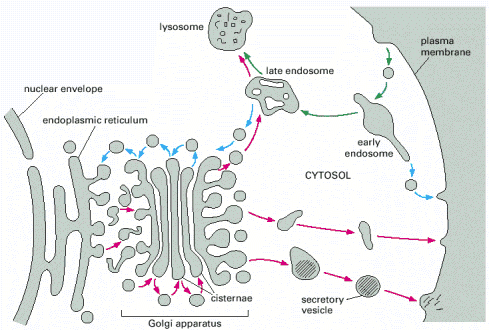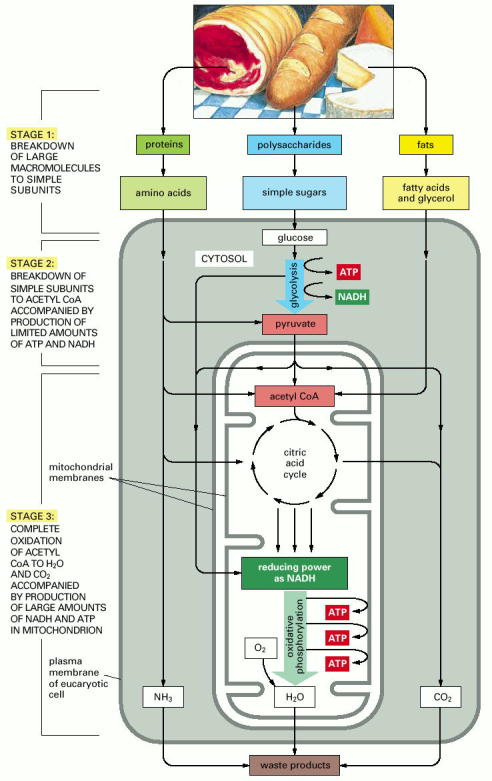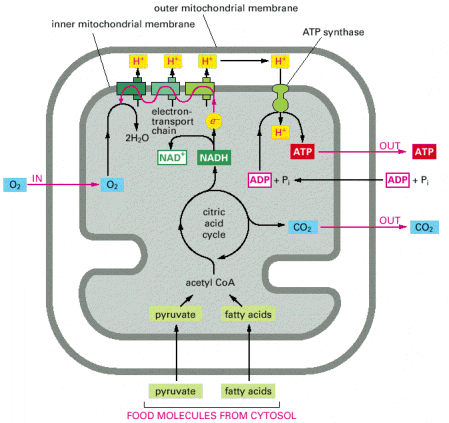
| MadSci Network: Cell Biology |
Hi there,
This is a great question! We need to separate the answer to your question into two parts, because two different systems are responsible for the processes you mentioned. The digestive system deals with food, and the respiratory system gets oxygen from the air we breathe.
First, let's be clear about what the endoplasmic reticulum does. The first major role of the endoplasmic reticulum (ER) is to separate newly-synthesized proteins away from the cytosol and assemble them into larger complexes. The second major function of the ER is to attach a sugar molecule to proteins that serves as a molecular zipcode to tell the cell where to send the protein as the protein moves through the secretory pathway. The third major function of the ER is to degrade misfolded proteins (via a process called the unfolded protein response). So, if too many misfolded proteins accumulate in the ER, there is a system to get rid of them. Finally, lipid bilayers that make up the plasma membranes and other organelle membranes are largely assembled in the ER. This is described in the figure below.

Now, onto the rest of your question, let's start with digestion. When food is digested by the digestive system, the digested materials—including amino acids, sugars, and fats—are absorbed into the blood stream from the small intestine into a large vein. The materials are transported in the bloodstream to appropriate cells in the body (sugars go to the liver) and they enter the cell through specialized membrane transporters.
Once inside the cell, sugars enter the glycolysis pathway in the cytosol. From there, the products of glycolysis are transported across the inner membrane of the mitochondria via specialized transport proteins. [It is important to note here that the end products of glycolysis (e.g., pyruvate and NADH) are not sugars. Sugars are not transported into the Mitochondrion. -- Moderator] This is a really important point! The molecules that arise from digested sugars do not just diffuse across the mitochonrial membrane! As the carrier protein in the inner mitochondrial membrane brings the molecules from digested sugar in, they also bring in a proton which has a positive charge. The outside of the inner mitochonrial membrane is positively charged and the inside is negatively charged, so when a proton moves in, it's moving with the voltage gradient, which energetically supports the movement of the digested sugar molecules (pyruvates) into the mitochonria as well. This is described in the figure below.

Summary for part 1: Broken down sugars in the cytosol are converted into a special molecule called pyruvate via glycolysis. Pyruvate is imported into the inner mitochondria by special pumps that also bring in a proton, which is an energetically favorable move that allows pyruvate in too. This is described in the figure below.

Now, for the oxygen. Oxygen can diffuse freely across the cell's membranes, so the ER isn't involved in any way in oxygen transport. There is a lot of blood chemistry I could go into to explain oxygen transport to the cell from lungs, but to keep the answer on point, I'll leave it at that.
I hope this was helpful for you! Please consider visiting the following website to browse upper-level textbooks on the subject:
It's the BookShelf for the National Center for Biotechnology Information. Three texts I recommend in particular are:
Please feel free to ask more questions and let me know if there is a better way to answer your questions in the future, I want these to be as clear and helpful as possible!
Try the links in the MadSci Library for more information on Cell Biology.